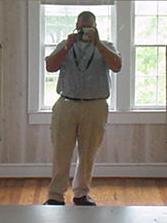Typing
Lee and I went to a wedding this weekend at Frank Lloyd Wright's Unity Temple in Oak Park, IL. Here's what the National Historic Landmarks program has to say about the building:
Designed in 1905 by Frank Lloyd Wright and completed in 1907, this is the first monumentally expressed use of reinforced concrete as an artistic architectural medium and also a prime and early example of modern church architecture. Wright was a member of the congregation that still uses the building he designed "for the worship of God and the service of Man."
But the main point of this post is that I couldn't help thinking of Spencer when we arrived at this icon of Western modernist architecture only to come face-to-(type)face with another classic symbol of Western modernism--the typewriter. The wedding couple had replaced their guestbook with three antique typewriters (one very antique--the "John Boy Special," I called it) in place of a guestbook, with instructions to 'sign' by typing them a message. It's amazing how baffled everybody--myself included--was at the prospect of having to compose on a typewriter. The most common question: "Where's the return key?" One guest, accustomed to seeing the cursor of word processing "move" from the right side of the screen to the left, even had trouble--and even after being explicitly told what to do--understanding that the platen (i.e., the rubbery cylinder that provides a backing for the paper) needs to move to the right to get the type back to the left side of the page.
The table they put the typewriters on was low, and there were no chairs, so many people got down on their knees to type their messages. In one picture I took, it looks as if the three people writing their messages are kneeling together in prayer before some kind of altar, which makes an interesting comment on the difference between typewriters understood as specific kinds of writing technologies and typewriters held up as objects of nostalgia in an age of word processing.
Apologies for not posting the photos, but I haven't uploaded them yet. I'll post them when I do.




2 Comments:
Interesting! This scene you describe seems to depend on the typewriter being an archive of nostalgia -- something I sometimes see in document design relying on images of typewriters. Neat story!
Wonder what it will be that makes us nostalgic for MS Word?
Post a Comment
<< Home